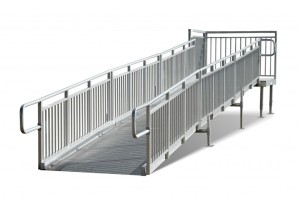Properties in New Jersey can benefit from aluminum wheelchair ramps, as these can allow people with unique mobility requirements to get up and down a property without a struggle. Your ramp must be strong enough to handle the weight of various wheelchairs, plus it has to meet rules established by the New Jersey Administrative Code and the New Jersey Accessibility Code 2009. REDD Team can work with New Jersey state rules to produce quality wheelchair ramps for your property.
Aluminum Is Ideal For Your Ramp
 Our workers at REDD Team use high-quality aluminum to produce our wheelchair ramps. Aluminum is a sturdy metal that will last for years, as it resists corrosion and rust. The design also responds well to various temperature changes, so it will not become dislodged or warped due to excess heat or cold.
Our workers at REDD Team use high-quality aluminum to produce our wheelchair ramps. Aluminum is a sturdy metal that will last for years, as it resists corrosion and rust. The design also responds well to various temperature changes, so it will not become dislodged or warped due to excess heat or cold.
Aluminum can also handle substantial amounts of weight, so it can manage multiple wheelchairs throughout the day. Considering how some wheelchairs can weigh a few hundred pounds, having an aluminum material for your ramp will be helpful.
Aluminum is also lighter than steel, so it is easier to install on your property. Aluminum can also be easily prepared in various shapes, so you can get a quality ramp that fits your location’s unique needs. REDD Team can prepare your ramp before delivery, ensuring the installation process remains safe and simple.
What Rules Come With Producing a Ramp?
Your aluminum wheelchair ramp must follow the rules established by the state of New Jersey. Here are some rules we can follow when getting your ramp ready:
- The running slope will be from 1:20 to 1:12.
- For existing sites, the slope can be 1:10 to 1:8 if the maximum rise is 3 inches. The slope can also be from 1:12 to 1:10 if that maximum rise is 6 inches.
- The cross slope cannot be steeper than 1:48.
- The ramp must be 36 inches wide. The handrails you add to the ramp cannot interfere with the 36 inches, so the ramp width will likely have to be greater than that total.
- The rise can be up to 30 inches for a single run. You will require an additional landing in your ramp if the rise will be any higher.
- All landings on the ramp must be at least 60 inches long and as wide as the broadest segment on the ramp.
- For cases where there’s a 180-degree turn midway through the ramp, the landing for that turn must be at least 60 inches on each side.
- Handrails are necessary for all ramps where the rise is greater than six inches. The rails should be about 34 to 38 inches above the walking surface.
- Edge protection is necessary for ramps where handrails are present. The protection should be about half an inch in height at the most.
The terms for getting your ramp for your New Jersey property are extensive, and you must ensure your ramp works best on the standards the state has imposed. REDD Team will be there to help you find a plan for your ramps that will meet your property needs. Contact us at (800) 648-3696 or online to learn about our services and how we can help you get a quality ramp ready at your property in New Jersey.
